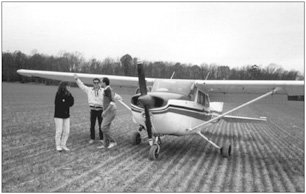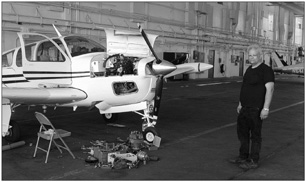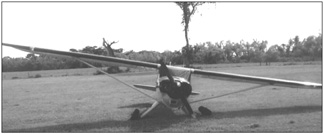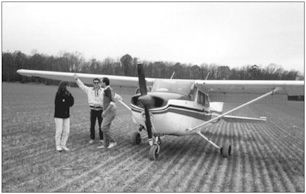
But it only has one engine! What happens when it quits?
If youve heard that once from a non-pilot, and youve been flying for any length of time at all, youve heard it a thousand times. Yes, aircraft engines do fail-theyre mechanical devices, after all. But an engine failure doesnt automatically mean a fatal accident. In fact, many full or partial engine failures dont even result in an NTSB report or an FAA inquiry. Thats because most of them are handled successfully by the pilot and dont result in aircraft damage or personal injuries requiring any reports to the NTSB or any FAA enforcement actions. That says a lot of good things about pilot training and engine reliability.
Still, a dizzying array of forged, stamped and machined metal parts comprise the average airplane engine. And, if you fly a twin, you have twice as many such parts. If thats you, dont forget that piston twins, although not the subject of this article, have a much worse fatal accident rate than singles after an engine failure because their pilots mishandle the event.
Following are three stories of actual engine failures of single-engine airplanes, told by the pilots flying them, as well as the lessons they learned from the experience.
Field Of Dreams
The first sign of trouble was a slight cough and a little roughness in the 172s engine. I assumed it was carb ice, since we were in and out of cloud layers at about +2, so I pulled carb heat and checked the gauges halfheartedly while waiting for the ice to clear. My only feeling at the time was annoyance that my perfect trim job might be disturbed.
Annoyance was quickly replaced by fear when I saw the oil pressure gauge on zero. First things first-look down and see what we can see. We were over some farm land, so we can land here if we have to. Then, it was time to set the transponder to 7700-my first time ever-and call Mayday. We were on an IFR flight plan so we didnt switch to 121.5 MHz. When asked if there were any nearby airports, ATCs response was, No.
The engine was failing rapidly at this point, so we headed down to survey a likely farm field. One of my backseat passengers spotted wires across it so we moved over to another one that turned out to have no wires. By now we were down to around 2000 agl and ATC came back with vectors for an airport several miles away. I informed them we were essentially a glider at this point and were landing where we were. Oddly, the controller told me I had to land at an airport and could not land in a farm field. I repeated that we did not have much choice anymore. There was no way I was leaving the safety of our nice big field!
The field appeared at least 2500 feet long, so it wouldnt be a real challenge on a normal day. It did have the proverbial 50-foot trees at the end, but the real obstacle was excess adrenalin that reduced my flying skills quite a bit. We were a little hot when we cleared the trees, so I did a full slip all the way from the treeline to the flare.
After landing and bumping along through the winter wheat, I shut down and we climbed out. We pushed the airplane out of the middle of the field and sent two people out to find someone to give us a ride. I stayed with the airplane and used the radio to ask another airplane to relay to ATC that we were all fine and no one was injured.
Eventually the FAA showed up and the inspector really thought the fuel valve being turned off had something to do with our farm field excursion. I reminded him that this was a standard pre-landing procedure for off-airport landings and invited him to try and run the airplane. The awful grinding convinced him the engine had really failed and he went away without writing any violations.
The engine turned out to have a failed oil pump. The engine was swapped out and the airplane flew out of the same field with no damage.
-Joe Della Barba
Swallowed Valve
It was a fine afternoon in early April over north central Florida. I was flying my Debonair with two pilot-friends (one of whom was my mechanic) back to Virginia after our annual pilgrimage to Sun n Fun. On an IFR flight plan, we had just leveled at 9000 feet and were settling in for the three hours it would take to get home.
Without warning, the engine started running rough-really rough. A glance at the engine analyzer told me that all cylinders on the IO-520 engines starboard side were acting up, with #5 the worst. As I tried to find a power setting that worked better, I glanced at my friends-they were a couple of shades paler than when we had taken off and their faces wore the same look of concern that I felt.

A call to say that we had a problem shut off chatter on the frequency I was using and the controller asked who was reporting the problem. We were a few miles south-southwest of Jacksonville, Fla., and looking out the windshield at one of the longest runways on the eastern seaboard, Cecil Field, a former Naval Air Station. The controller offered Cecil as a safe haven; we accepted and confirmed that, yes, we were declaring an emergency and to have the emergency equipment roll.
By this time, I had punched off the autopilot, pitched for the planes best glide speed and re-trimmed. The engine was still running, very roughly, but there was no way to know how long that would last.
After the obligatory recitation of souls and fuel on board, I got busy trying to land. We still had power and actually had too much altitude. As we descended out of 4000 feet close to the field, I picked a spot I determined as a key point from which I could make the runway if the engine quit for good. Maintaining our best glide speed, I made two 360 turns to lose altitude but stay in the same area. Then, we were down to about 2000 feet agl and I began a wide downwind for Runway 27L, which is slightly shorter than the monster Runway 36R, but still gave me 8000 feet to play with. I saved the gear and flaps until short final, still high, and ended up pulling off all the remaining power. We touched down uneventfully and taxied to the ramp, trailed by the emergency vehicles.
Subsequent investigation revealed that the #5 cylinder had swallowed its intake valve, breaking it into at least five pieces. A few days later, after hanging a new cylinder and doing some test flying, I flew the plane home, a week later than planned.
-Jeb Burnside
Student Cross-Country
On my first student cross-country solo, several mistakes on my part added up to an emergency off-airport landing. I was flying a Luscombe 8F with an upgraded 150-hp engine on a 90-mile trip from La Porte, Texas, to Palacios, Texas. The trip to Palacios was uneventful, with the exception of the steadily lowering clouds. Once I had the airport in sight, however, things started to go sour. The airport looked abandoned and, while it was supposed to be my destination, I worried about fuel availability and a myriad other what-ifs.
After circling a few times I tried to raise someone on the radio. Another Unicom operator was monitoring the frequency and reported that no one was at Palacios. I elected to turn around and fly back home.
About 15 minutes later, I tried to switch fuel tanks. In the Luscombe, there are two fuel valves, one on either side of the cabin. Because I could not reach the right one while wearing the shoulder harness, my standard procedure was to start the flight on that one and then turn on the other one later. As I reached down to turn on the left tanks valve, I discovered that I couldnt move it. I tried repeatedly to turn it on, first one way and then the other. No joy.
About halfway home, between airports, the engine quit as the right fuel tank ran dry. Horrified, I renewed my efforts to turn the valve. I was at less than 1000 feet agl and the view outside my windows held only trees and railroad tracks. I turned south for reasons unknown.
I was intent on trying to get the fuel valve opened until, for whatever reason, a memory flashed through my mind of an airline crash resulting from its crew becoming distracted. At that point, I decided to quit messing with the valve and fly.
I spotted a small field when I was at about 300 feet agl. But, as I got closer to it, I realized it was too short and there was a canal at the end in which I would end up. At 50 feet, I just barely cleared some trees into the next field. I did my best to set up a three-point landing, but must have stalled the last few feet-I really dont remember. That and the subsequent roll through a series of ruts weakened the gear legs.
With all the weight on the left side of the airplane (me and the other fuel tank), the next few ruts caused the gear to collapse completely. At that point, the airplane swung around almost 180 degrees and came to an abrupt halt. The plane, with the exception of the landing gear, was fine.
It took me a while to get back in the cockpit after what I perceived as really stupid actions on my part. I wasnt afraid of airplanes, I was afraid of myself. Its something with which I still battle.
-Katie Jarrett
Lessons Learned
Several common themes run through these three engine-failure tales. First, fly the airplane. All of them were successful because the pilots training took over; no one tried to stretch a glide and stalled in a turn to final.Accept the likelihood of damaging the airplane and do everything you can to maintain control until it comes to a stop.
Second, altitude is your friend. It gives you time to run checklists, communicate, troubleshoot and find the key position from which to make a deadstick landing if you have to.

Third, use all the resources available. Despite one controller suggesting that an airplane with a failed engine has to land at an airport, controllers can be a great deal of help. Dont forget the passengers, either. As one event recounted here demonstrates, a backseater devoted his sharp eyes and concentration to spotting wires.
Fourth, pay attention to where you are. In those bad old pre-GPS days, it was sometimes a lot harder to figure out the nearest airports location. Without a GPS, follow along on your Sectional, just like your grandparents did.
Finally, dont be in a hurry-the nearest airport might be within range if you immediately go to the best-glide airspeed instead of descending lower to survey terrain. Similarly, dont leave the area youre over if you have a good spot to land. There is no good reason to glide over wooded areas to try to get to an airport.
The ideal spot to suffer an engine failure in a single is in the landing flare at your home airport. With some altitude, hospitable terrain and good weather, an engine failure should be nothing more than what you practiced in the pattern, capped by an off-airport landing. Follow your training and fly the airplane.
Also With This Article
“Anticipating Engine Failure”
“Rule Number One”




